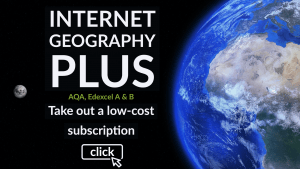Home > Geotopics > What is the evidence for human activity causing climate change?
What is the evidence for human activity causing climate change?
Introduction
Human activities, particularly the burning of fossil fuels, deforestation, and industrial processes, have significantly increased the concentration of greenhouse gases in the atmosphere, leading to observable changes in the climate. This page examines the evidence of human-induced climate change, including sea level rise, warming oceans, global temperature rise, declining Arctic ice, and increased extreme weather events. We will also explore the possible consequences of these changes on people.
Evidence of Human-Induced Climate Change
Sea Level Rise and Warming Oceans
- Sea Level Rise: One of the most direct indicators of climate change is the rising global sea level. This is caused by two main factors: the thermal expansion of seawater as it warms and the melting of glaciers and polar ice caps. Satellite measurements show that global sea levels have risen by about 20 cm since the late 19th century.
- Warming Oceans: The world’s oceans have absorbed much of the excess heat from global warming, increasing sea surface temperatures. Warmer oceans contribute to ice melting and affect marine life and weather patterns.
Global Temperature Rise
- Temperature Records: Global surface temperatures have risen significantly since the late 19th century. The last few decades have seen the most rapid warming. According to NASA, the average global temperature has increased by about 1.2°C since pre-industrial times.
- Heatwaves: The frequency and intensity of heatwaves have increased worldwide. Extreme heat events have become more common, posing risks to human health and agriculture.
Declining Arctic Ice
- Arctic Sea Ice Extent: The Arctic region has experienced some of the most dramatic changes due to global warming. The extent and thickness of Arctic sea ice have declined rapidly over the past few decades. Satellite data show that summer’s minimum sea ice extent has decreased by about 40% since 1979.
- Permafrost Thawing: Rising temperatures in the Arctic are also causing permafrost, or permanently frozen ground, to thaw. This releases methane, a potent greenhouse gas, further exacerbating climate change.
Increased Extreme Weather Events
- Storms and Hurricanes: Evidence shows that the intensity of hurricanes and tropical storms has increased. Warmer sea surface temperatures provide more energy for these storms, leading to more powerful and destructive events.
- Floods and Droughts: The frequency and severity of floods and droughts have increased in many regions. Changes in precipitation patterns and more extreme weather events lead to these conditions.
- Wildfires: Higher temperatures and prolonged dry periods have contributed to an increase in the frequency and intensity of wildfires, particularly in regions like Australia, California, and the Mediterranean.
Increase in Carbon Dioxide (CO2) in the Atmosphere
- Rising CO2 Levels: The concentration of carbon dioxide (CO2) in the atmosphere has increased significantly due to human activities such as the burning of fossil fuels, deforestation, and industrial processes. Pre-industrial levels of CO2 were approximately 280 parts per million (ppm), but current levels have surpassed 410 ppm.
- Impact on Climate: CO2 is a major greenhouse gas, and its increased concentration enhances the greenhouse effect. This means more heat is trapped in the Earth’s atmosphere, leading to global warming. Elevated CO2 levels are directly linked to the rise in global temperatures, melting ice caps, and changing weather patterns.
- Long-Term Effects: CO2 has a long atmospheric lifetime, meaning it accumulates over time. Even if emissions were to stop immediately, the existing CO2 would continue to warm the planet for centuries. This long-term presence contributes to sustained climate changes, affecting ecosystems, sea levels, and weather patterns globally.
Possible Consequences on People
- Impact on Coastal Communities
- Flooding: Rising sea levels increase the risk of coastal flooding, threatening homes, infrastructure, and livelihoods. Low-lying areas and small island nations are particularly vulnerable.
- Erosion: Higher sea levels and more powerful storm surges accelerate coastal erosion, leading to the loss of land and habitat.
- Health Risks
- Heat-Related Illnesses: Increased temperatures and more frequent heatwaves pose significant health risks, including heatstroke and dehydration, particularly for vulnerable populations such as the elderly and young children.
- Air Quality: Higher temperatures can worsen air quality by increasing ground-level ozone, leading to respiratory problems and exacerbating conditions like asthma.
- Agricultural Impacts
- Crop Yields: Changes in temperature and precipitation patterns can affect crop yields. Some regions may experience reduced agricultural productivity, leading to food insecurity.
- Water Availability: Altered rainfall patterns and increased evaporation rates can reduce water availability for irrigation, affecting both crop and livestock production.
- Economic Consequences
- Damage to Infrastructure: Extreme weather events, such as hurricanes, floods, and wildfires, can cause extensive damage to infrastructure, leading to costly repairs and economic losses.
- Displacement: Climate change can force people to migrate due to the loss of homes and livelihoods, leading to social and economic challenges in both the affected and receiving areas.
- Ecosystem and Biodiversity Loss
- Habitat Destruction: Changes in climate can lead to habitat destruction, threatening species with extinction. Coral reefs, for example, are susceptible to temperature changes and are experiencing widespread bleaching.
- Species Migration: Many species are forced to migrate to new areas with suitable climates, disrupting ecosystems and biodiversity.
Future Projections
Sea Level Rise
It is estimated that 23% of the world’s population lives within 100 km of the coast (2003). Many of these people reside in small coastal settlements, but numerous major cities are also located on or near the coast. Some of the most densely populated areas globally are situated on the fertile deltas of major rivers, where rivers meet the sea.
A rise in sea level of 1 metre would have severe consequences for coastal regions:
- Low-Lying Island Nations: Countries such as the Maldives could be submerged.
- Flooded Land: Areas like Bangladesh could lose 17% of their land area and 50% of their prime farmland, displacing tens of millions of people who would need new homes and agricultural land.
- Sea Defences: The construction of new sea defences would be necessary, costing enormous sums. For instance, in urban areas of the USA, this could amount to US$200 billion.
- Saltwater Contamination: Farmland and groundwater supplies would be contaminated by seawater.
Projections for Sea Level Rise
Predicting the exact rise in sea levels is challenging due to numerous variables:
- Greenhouse Gas Emissions: The future trajectory of emissions is uncertain. Climate change organisations have modelled four scenarios: (1) emissions peak by 2020 and then decline, (2) emissions peak around 2040 and then decline, (3) emissions peak around 2080 and then decline, and (4) emissions continue to rise throughout the 21st century.
- Melting Ice Sheets: The potential melting of the Greenland and Antarctic ice sheets could significantly raise sea levels by 7 and 13 metres, respectively. Complete melting would take many centuries.
- Regional Differences: Sea level rises will vary by location due to prevailing winds, ocean currents, and local land subsidence. Areas like the USA’s Gulf Coast, where the land is sinking and populations are dense, are at particular risk.
Increased Temperatures
Rising temperatures have multiple impacts beyond causing sea level rise through thermal expansion and ice melt:
- Food Production: Changing temperatures may shift the regions where different crops can be grown.
- Pests and Diseases: Warmer winters may no longer limit the spread of some pests and diseases.
- Water Supply: The disappearance of glaciers could result in important rivers drying up during parts of the year.
- Biodiversity: Changing habitats may reduce biodiversity as plants and animals struggle to adapt to rapidly changing conditions.
Extreme Weather Events
Climate change, by altering the long-term weather patterns of an area, also affects weather events. There has been a noticeable increase in the frequency of extreme weather events, such as:
- Tropical Cyclones: More intense and frequent cyclones.
- Droughts: Prolonged periods of drought.
- Flooding: Increased flooding due to intense and prolonged rainfall.
- Snowfalls: Heavier snowfall events.
These extreme weather events can be deadly and cause substantial damage to property and possessions. An increase in such events is likely the most immediate and tangible impact of climate change experienced by many people, although not all extreme weather events are solely attributable to climate change.
Related Topics
Use the images below to explore related GeoTopics.



